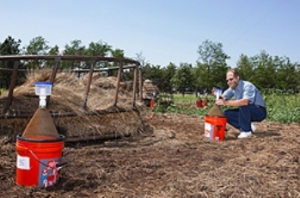The Solutions for dairy sector
Catnip and Cyromazine to Control Growing Stable Fly Problem

Scientists at the Agricultural Research Service’s Agroecosystem Management Research Unit (AMRU) in Lincoln, Nebraska, are looking into better control and prevention methods so farmers are better equipped to beat stable flies.
Distinction from other flies is important urge the University of Nebraska extension team because by clustering together they make damaging inroads on cattle health which can result in milk yield falling in dairy cows.
Insecticide spray is effective but consider the effects of wet grass and wading through water courses on dose efficacy, urges Lincoln University entomologist, David Taylor .
Management of this pest is further complicated by the fact that larval development sites exist for only a short time, are difficult to find, and can produce huge numbers of the aggravating flies.
Stable flies, despite their name, have moved out into pastures over the last 30 years and Mr Taylor recommends feeding stations as places to target treatment.
“The accumulation of wasted hay, manure, and urine at these feeding sites creates an ideal habitat in the pasture for stable fly larval development,” Mr Taylor says.
Mr Taylor recommends growth regulators like Cyromazine are applied via automatic sprayers. Cyromazine has been used to control other flies in poultry farming and works by inhibiting development of the insect skeleton.
“It’s something producers can put in a pickup truck and don’t have to mix or spray,” adds Mr Taylor.
“They can quickly treat sites while doing other chores or checking on cattle.”
Up to 97 per cent stable fly reduction has been recorded on hay feeding sites. For each feeding site the method takes 10 minutes to apply, $10 to fund and lasts 10 to 20 weeks per site, says Mr Taylor.
 Entomologist David Taylor adjusts the settings on a sprayer used to automatically treat cattle with a stable fly repellent
Entomologist David Taylor adjusts the settings on a sprayer used to automatically treat cattle with a stable fly repellent
The best tool is prevention and entomologist Jerry Zhu recommends catnip as a low toxic substance to confuse the senses of fly antennae.
“When gravid females—flies with eggs—reach an egg-laying site, we believe they use the olfactory sensors on their antennae to gather information related to nutrition.
“They then make a decision as to whether it is the right area to lay their eggs,” says Mr Zhu.
The active compounds- nepetalactones- are powerful repellents against stable flies, adds Mr Zhu, who also notes the qualities of catnip as a larvicide.
For Mr Taylor and Zhu the priority is to form a cultural solution rather than dependence on chemicals. Developing cattle production methods without providing larval development sites for flies is the main goal.




















